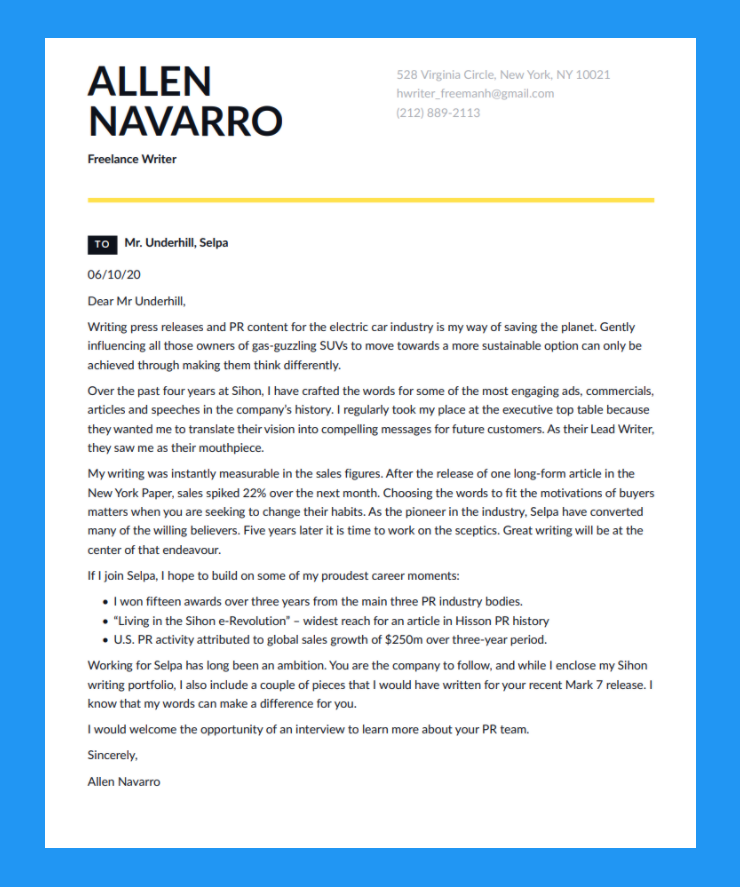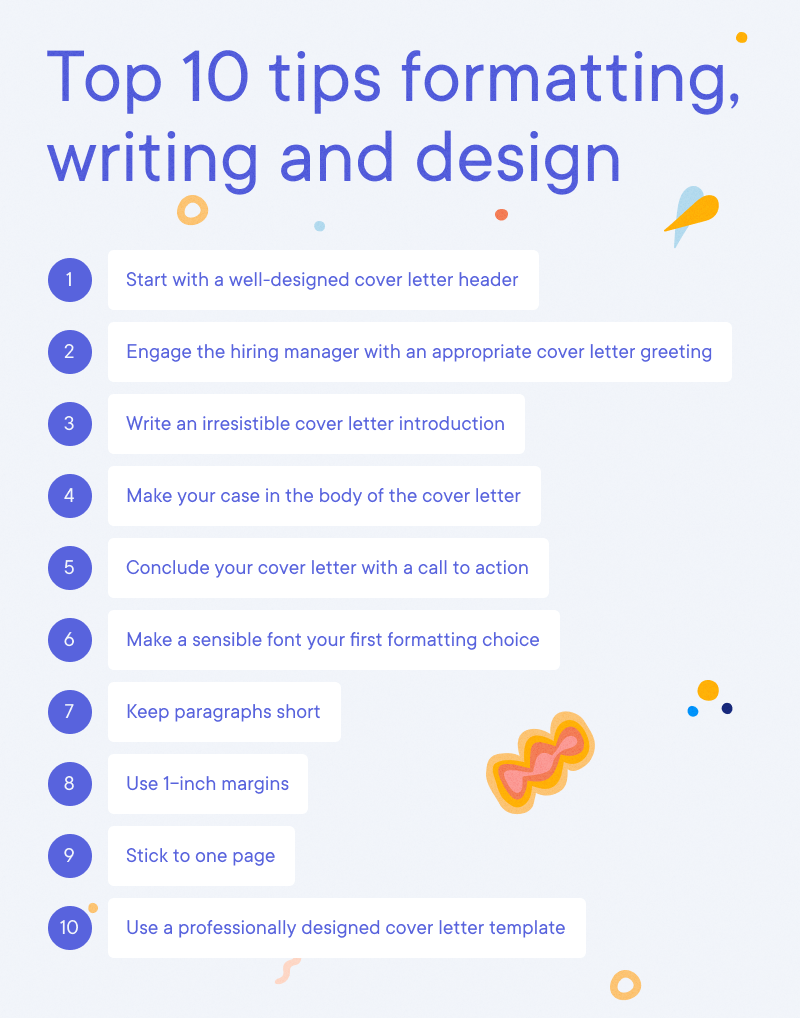It may be the most important letter you ever write. Your carefully crafted cover letter could lead to lifetime job satisfaction, buy you a home, or put your kids through college. So, are you wondering if the format of the cover letter matters?
You know your field, you know your skills, and you know the people you want to work for. Now all you have to do is write them a one page letter. Every journey to your dream job begins with a standout resume and stellar cover letter.
But whether you’re a rocket scientist or a railroad worker, you may experience a brain freeze when faced with this blank sheet of paper. and this seemingly simple task. And it IS a simple task, although not necessarily easy.
It’s actually one of the ultimate feats of persuasive writing: a one-page letter so compelling it lands the writer a new job. It is the type of letter that can change your life. So what are the secrets to getting this crucial part of your job application right? What is the proper format for a cover letter? How do you start and end a cover letter? What do employers look for in a cover letter?
How to Format a Cover Letter
While the content of your cover letter will be completely unique, the elements are standard. Proper cover letter format includes:
- The header
- The salutation
- The body or paragraphs in between
- The Conclusion and Call to Action
- The Signature or Signature
Now that you understand the components of a cover letter format, here are our top 10 tips for the cover letter. cover letter format, writing and design. Below is a complete sample cover letter format, followed by our top 10 tips for formatting, writing, and designing cover letters.

1. Start with a well-designed cover letter header.
A good cover letter design starts with a header, an electronic version of what used to be called a letterhead. This is the space at the top of the page that contains your name, address, phone number, and email. (Sometimes the mailing address is omitted, and sometimes people add their contact information for LinkedIn or other platforms.)
The main purpose of the header is to convey your critical contact information so that the potential employer knows how to reach you.
But the secondary purpose of the header is also important: to provide an attractive design element at the top of the page. Everything below the header will be black-body text, which will hopefully be interesting to read, but unfortunately not very interesting to look at.
The header is critical because it’s the only place on the page where you have real design options. You can opt for color, creative use of typography, and other touches that start your page off with a visual bang. That doesn’t mean it has to be flashy or loud, but it does have to be easy on the eyes.
You can check out Resume.io’s collection of cover letter format examples to get an idea of some good design options for your header.
2. Engage the hiring manager with an appropriate cover letter salutation.
In the old days, it used to be fine to write “To Whom It May Concern,” “Dear Sir or Madam,” or even “Gentlemen” in a salutation cover letter. But those days are gone.
Always try to address your letter to a specific person. If the job posting doesn’t mention the hiring manager’s name, do some research and make a call if necessary to find out who makes the decisions in the job you want.(But don’t misspell that person’s name, and make sure you know which title they prefer.)
Psychologists have found that people get a little emotional reading their own names, and it tends to make them sit up and pay attention. Also, a letter addressed to a specific person is more likely to be responded to than a letter sent to an entire department. In some cases , it is possible that the name of the manager against It is purposely not disclosed, and if so, you may need to say something more generic like “Dear Hiring Manager” or “Dear (Company Name) Hiring Team.”
3. Write an irresistible cover letter introduction.
In the opening paragraph of your cover letter, you should make an opening statement that makes a decisive case. Find a way to introduce yourself, identify the job you’re looking for, and provide a preview of why you’re eminently qualified for this job. Your cover letter introduction should have the right tone of voice from the start: friendly, enthusiastic, confident, competent, but never arrogant or conceited. Your introduction should grab the reader’s attention, but for the right reasons.
Above all, your opener should make a positive first impression and give your reader a reason to keep reading.
Here is an example of a good cover letter:
4. Make your case in the body of the cover letter.
In the body of your cover letter, you should build a persuasive case that you are the right candidate for the position. You may need to brag a bit, and that’s okay, because if you don’t promote your candidacy for this job, no one else will.
Talk about your work experience and be specific about your accomplishments in previous jobs. Whenever possible, use facts and figures (numbers, dollar figures, percentages) to quantify your achievements and work history. Also, go where your resume can’t tell an anecdote about a problem you once faced and how you solved it.
A frequently asked question is: Are bullet points acceptable in a cover letter? The short answer is yes. The longer answer is: Use them sparingly and think about whether they benefit the visual aspect and reading flow of your cover letter. What you don’t want is to turn your cover letter into a second resume.
The body of your letter can also mention your education, certifications, and relevant skills. And you may choose to discuss your aspirations for the future, specifically as it relates to the position for which you are applying. Be sure to carefully study the job description and show that you meet the requirements of the job. (But, obviously, you need to be honest, because any falsehood on a job application will come back to haunt you.)
The tone of your writing is important, too. To match the language and level of formality, check your prospective employer’s website, social media accounts, and any other material you can find.
Here is an example of a cover letter body:
5. Conclude your cover letter with a call to action.
Your closing paragraph can include a summary, a thank you, and anything else important that you haven’t said yet. But your conclusion should also contain a call to action: a suggestion that you’d be happy to come in for an interview, or even just talk on the phone. You may also want to say that you are always available at the contact information provided.
Make it clear from your contact that you take this job seriously and are genuinely eager to follow up.
End with an appropriate closing phrase, such as “Sincerely,” “Respectfully,” or “Best regards.” Then write your name below or add your signature if you plan to mail it. letter or deliver it in person.
Be sure to review your letter carefully, and ideally find a good editor to proofread it for you. Typos and other errors in English are among the top reasons why cover letters and resumes are rejected.
Here’s an example of how you might write the conclusion to your cover letter:
6. Make a sensible font your first format choice.
Good choices for a cover letter format start with a good font. Use a modern, attractive, and easy-to-read cover letter font—nothing too flashy or exotic, nothing attention-grabbing. You want people to read your copy, not stare at your weird font choice. Take a moment to read our article on “What are the best fonts for cover letters?”
Choose a font size between 10 and 12 points: smaller and it’s hard to read, larger and it starts to look like a Mother Goose book.
Align text to the left, in a style known as “ragged right” because it leaves a space to the right of the last word of each line. Justifying text from one margin to the other makes the page appear to be filled with solid blocks of black text, and sometimes stretches words horizontally to reach the margin.
7. Keep the paragraphs short.
Keep the paragraphs short, add a space between them, and don’t indent.
It used to be fine to send a business letter with no spaces between paragraphs, as long as each paragraph was indented. But these days, unless you’re writing a book, you need non-indented paragraphs with a space between them.
And you should keep your paragraphs fairly short and keep their length consistent. If you received a one page letter containing 400 words all in the same paragraph, would you expect to read it? The eye needs a rest, and the brain too. That’s why paragraphs were invented.
8. Use 1-inch margins.
Allow 1-inch margins at the top, bottom, right, and left of your cover letter.
There is a saying among page designers, both print and digital : “Blank space is your friend.” Every element of design, illustration, or art needs to incorporate a certain amount of negative space that contains nothing at all.
Designers will also tell you to avoid “trapped white space,” which means inconvenient white space in the middle of your design. That is why the white space should be “pushed to the outside”, providing a kind of invisible frame that allows the central image to dominate.
This is the idea behind the margins: it is a frame. white that surrounds and highlights your content.
9.Stick to one page.
You might also consider it a cardinal rule that the length of your cover letter cannot exceed one page. However, anyone who has tried to write one can probably testify that the first draft is often too long.
You may be tempted to reduce the font size, reduce the margins, or get rid of all the Blanks. But resist the temptation to atone for your verbosity by changing the format. Trim fat from your text before resorting to measures that will make the type denser and harder to read.
10. Use a professionally designed cover letter template.
There is an easy way to get around the potential pitfalls of formatting a cover letter and that is to use a professionally designed cover letter template.

A cover letter template is a pre-built framework that already has an eye-catching cover letter header, proper typography, and proper use of white space. All you have to do is replace the existing text with your own, and your letter is ready.
For more information, click on this video, “How to Format Your Cover Letter,” from the Southern University of California Career Center.
Take a moment to review Resume.io’s cover letter examples, find a template you like, and customize it to make it your own. You will be building on a foundation of success.
.
